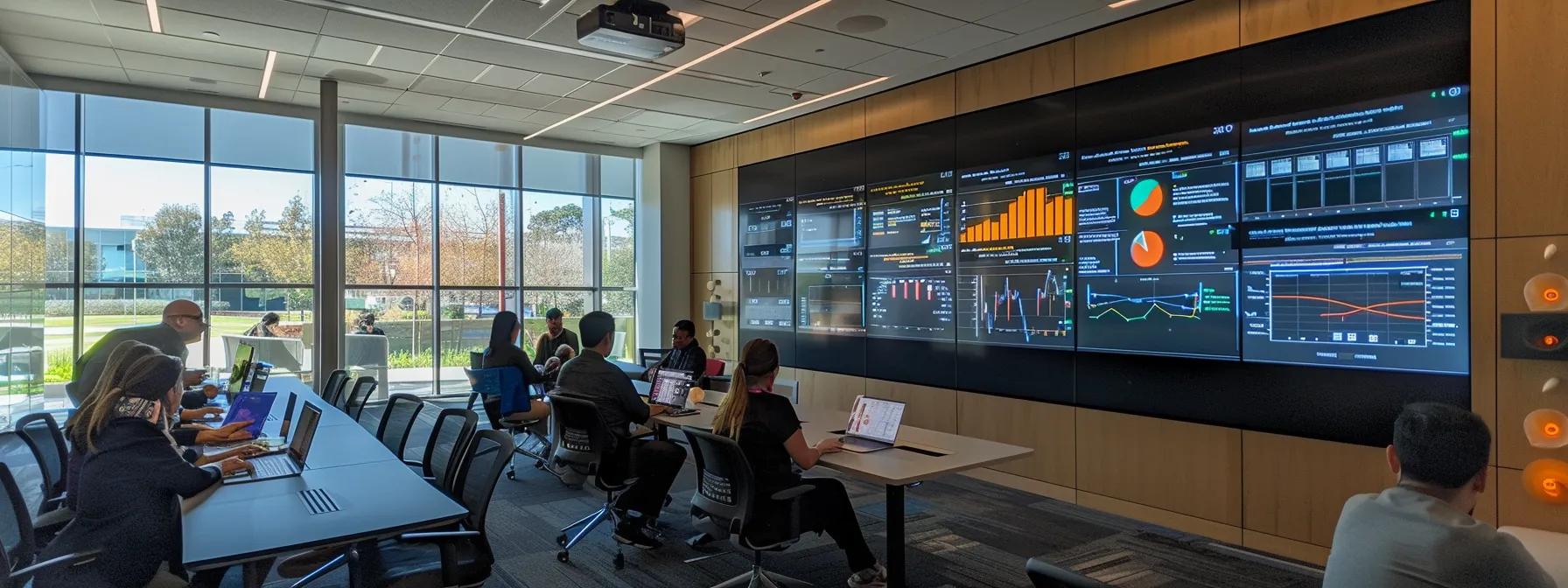In today’s dynamic business landscape, customer relationship management (CRM) systems are critical to driving growth, increasing customer retention, and boosting sales performance. Organizations are leveraging tools that focus on granular analytics and predictive insights to optimize marketing automation, enhance personalization, and reduce customer acquisition costs. This article outlines a comprehensive framework for maximizing CRM success by focusing on key performance indicators (KPIs) and success metrics that directly affect digital marketing, sales, and customer service. By measuring everything from lead conversion rates to customer lifetime value and retention, advanced CRM systems help enterprises move towards robust enterprise resource planning (ERP) and increase operational efficiency.
Moreover, modern CRM platforms integrate machine learning and sentiment analysis to deliver real-time insights and recommendations. These tools allow companies to forecast market trends, drive actions based on data quality, and adjust sales pipelines accordingly to generate revenue growth. With the increasing focus on omnichannel strategies and seamless tool integrations, organizations are using detailed CRM metrics to guide resource allocation and optimize customer support efforts. The blend of quantitative data and qualitative feedback offers a multifaceted view of performance, ultimately enabling a more personalized, efficient, and profitable customer journey.
Defining Your Framework for CRM Success Metrics

Establishing a robust framework for CRM success metrics is essential for any organization that relies on customer data to drive business strategies. The first step is to define CRM success clearly in your context. CRM success is often measured by the ability to track customer interactions, enhance customer relationships, and drive more accurate forecasting for revenue growth. By understanding the total scope of your CRM’s impact on digital marketing and operational efficiency, organizations can focus on metrics such as lead conversion rate, customer lifetime value (CLV), customer satisfaction scores, and the retention rate.
Identifying Critical CRM Performance Indicators
The critical performance indicators for CRM systems include quantitative measures like the number of leads entered into the system, conversion rates, sales cycle length, and average deal size. In addition, qualitative metrics such as customer satisfaction and agent response times are essential. Organizations should include measures like contact frequency, open rate of email marketing campaigns, and first contact resolution rates to gain a comprehensive view of customer interactions.
Establishing Baselines for Your CRM Metrics
Once the critical indicators are identified, the next step is to establish baselines, which act as reference points. Baselines vary by industry and company size but typically include historical performance data followed by regular assessments. For instance, if the average lead conversion rate historically has been 20%, companies might set a target of increasing this to 25% through optimized workflows and targeted customer engagement initiatives. Furthermore, setting baselines encourages continuous improvement and helps in identifying any anomalies or areas requiring urgent attention. Detailed tracking over time also enables the use of machine learning algorithms for predictive analytics, offering insight into future customer behaviors and the best ways to optimize CRM functionalities.
Selecting Tools for Tracking CRM Success Metrics
Numerous CRM platforms offer comprehensive analytics dashboards and reporting tools that integrate well with other business apps, such as accounting software and email marketing systems. Tools like Microsoft Dynamics 365 and HubSpot provide built-in analytics, while independent platforms may integrate with Google Analytics for more in-depth performance tracking. The selection of the right tool depends on factors such as data collection frequency, reporting needs, user interface design, and the scope for customization. Modern systems leverage cloud computing to ensure real-time data access from various sources, thus supporting both reactive and proactive decision-making processes. Furthermore, employing sentiment analysis tools can provide qualitative insights that bolster quantitative metrics by interpreting customer feedback captured during interactions.
Setting Realistic Targets for CRM Performance
The final aspect of defining a CRM framework involves setting realistic and achievable targets. When targets are too ambitious, teams might become demotivated; conversely, targets that are too lenient may fail to stimulate progress. Targets should be SMART (specific, measurable, achievable, relevant, and time-bound) and consider industry benchmarks such as customer acquisition costs and churn rates. For instance, if CRM system analytics show that customer service satisfaction is rated at 80% on average, a realistic goal could be achieving a 5% improvement over the next fiscal year by streamlining support workflows and leveraging AI-based chatbots. This balanced approach ensures that all stakeholders remain aligned with the business’s strategic vision and operational capabilities.
Connecting CRM Success Metrics to Strategic Business Goals

Connecting CRM success metrics to overall company objectives is the bridge between operational efficiency and strategic growth. Organizations that align their CRM data with broader business goals often achieve higher return on investment (ROI) and more informed decision-making. Strategic alignment ensures that every metric tracked in the CRM system is purposeful and contributes to long-term objectives such as market penetration, customer retention, and revenue maximization. When success metrics are connected to key business drivers, it becomes easier to justify investments in CRM technologies and training initiatives.
Mapping CRM Metrics to Overall Company Objectives
Mapping CRM metrics to broader corporate goals requires identifying how each indicator supports specific objectives. For example, a company looking to boost customer lifetime value might focus on metrics such as customer retention rate, satisfaction scores, and upselling success. By linking these metrics to strategic initiatives, such as enhanced customer support or targeted marketing campaigns, companies create a cohesive strategy that unites different departments. A 2022 study conducted by MIT Sloan Management Review found that companies with a clear mapping of CRM metrics to company objectives improved ROI by up to 17% compared to those with fragmented strategies. This mapping creates a strategic narrative where every click, call, and customer interaction builds towards a larger financial return.
How Specific CRM Success Metrics Drive Revenue Growth
Specific CRM metrics drive revenue by providing actionable insights into sales processes and customer behaviors. For instance, closely monitoring the sales cycle length can pinpoint inefficiencies that delay revenue recognition and help streamline processes. Similarly, tracking average deal size across different market segments can signal where to focus marketing efforts to capture higher-value opportunities. Predictive analytics models built within CRM systems can forecast customer behavior trends that are essential for planning inventory or preparing for seasonal peaks. These insights allow companies to allocate resources effectively and generate strategies that directly influence the bottom line by reducing the customer acquisition cost while increasing the lifetime value of each customer.
Using CRM Data to Inform Strategic Decisions
Data-driven decision making in CRM is crucial for refining marketing campaigns and optimizing sales efforts. By integrating insights from CRM systems with broader market data, business leaders can identify trends and pivot their strategies accordingly. This holistic view, which also integrates feedback from customer service and social media engagement analysis, forms a reliable basis for innovations in product development or advertising strategies. For example, a global technology firm utilized CRM data to refine its sales tactics, resulting in a 15% increase in conversions by tailoring outreach methods based on the specific pain points identified through data analytics. This approach reduces guesswork and fosters a culture where strategic decisions are based on empirical evidence rather than intuition.
Communicating the Value of CRM Metrics Across Departments
Effective communication of CRM metrics across departments is vital to ensure cohesive efforts. Sales, marketing, customer support, and finance must all understand how these metrics translate into actionable insights. Regular cross-departmental meetings, dynamic dashboards, and automated reports help in disseminating these insights in real time. Training sessions that detail the direct correlation between CRM metrics and key performance outcomes bolster transparency and encourage ownership of the data. When every unit in an organization understands how improvements in CRM metrics impact the company’s strategic goals, internal collaboration accelerates. This unity is particularly relevant in a digital era marked by rapid technological changes and evolving consumer expectations, where agility can result in significant competitive advantages.
Key Sales Performance Metrics for CRM Success

Sales performance is a critical component of CRM success as it directly affects revenue generation and market competitiveness. Detailed monitoring of sales KPIs provides insights into how efficiently leads are converted, the duration of the sales cycle, and the average deal size. This section explores the key sales performance metrics that data-driven organizations rely on to measure CRM effectiveness. These metrics not only help refine the sales process but also provide direct feedback on marketing strategies and customer service effectiveness.
Monitoring Lead Conversion Rates as a CRM Success Metric
The lead conversion rate is one of the most crucial metrics in any CRM system. It measures the percentage of leads that ultimately become paying customers. A higher conversion rate signifies effective lead nurturing and a streamlined sales process. For instance, companies using advanced CRM analytics have reported improvements in conversion rates by as much as 20% by targeting leads with personalized marketing campaigns and automated follow-ups. Peer-reviewed research from the Journal of Business Research (2020) emphasized that integrating CRM conversion metrics with machine learning algorithms increased lead conversion by identifying high-potential clients through predictive analytics. Sales teams can use these insights to focus their efforts on leads most likely to convert, thereby reducing resource wastage and boosting overall efficiency.
Analyzing Sales Cycle Length With CRM Data
Sales cycle length—the time taken for a lead to move from the initial contact to closing a deal—is a key performance indicator that influences cash flow and resource planning. A shorter sales cycle generally implies that the CRM system is effectively streamlining the sales process, enabling faster revenue generation. Detailed CRM analytics reveal bottlenecks in the sales funnel, such as prolonged follow-up times or inefficient communication channels. For example, some companies have decreased their sales cycle by 15% over the course of a quarter by implementing targeted training and automated reminders within the CRM platform. The ability to track each stage of the sales process ensures that teams can intervene timely and maintain momentum throughout the pipeline.
Tracking Average Deal Size for CRM Effectiveness
Monitoring average deal size provides insights into the quality of sales interactions and the value generated per transaction. Larger deal sizes typically indicate better customer understanding and more effective upselling and cross-selling strategies. By analyzing historical data stored in CRM systems, companies can identify trends and adjust their pricing models or promotional offers accordingly. For example, firms using Salesforce have reported increases in average deal size by tailoring value-based solutions and offering bundled services. A multi-study review published in the Journal of Marketing (2021) emphasized that strategic interventions based on CRM data could improve deal sizes by as much as 10% through more effective sales presentations and targeted customer segmentation.
Assessing Sales Team Activity Levels via CRM Metrics
Sales team activity levels, including metrics such as call volumes, email outreach frequency, and meeting counts, offer valuable insights into overall team productivity. These quantitative measures enable organizations to identify both high-performing and underperforming individuals. When sales activity metrics align with successful conversion metrics, it demonstrates an effective synergy between effort and results. Tracking these activities in real time encourages accountability and allows for immediate corrective measures, such as additional coaching or resource reallocation, to optimize sales performance. Engagement data directly correlates with customer acquisition rates, especially when teams employ omnichannel communication strategies that integrate phone calls, social media, and email follow-ups.
Understanding Customer Acquisition Cost Through CRM Success Metrics
Customer acquisition cost (CAC) is a critical metric that determines the sustainability of sales and marketing strategies. It quantifies the total expenditure required to acquire a new customer, factoring in all CRM-related costs, including system maintenance, marketing campaigns, and sales efforts. Maintaining a low CAC is essential for ensuring profitability and long-term growth. Detailed CRM analytics provide a clear breakdown of spend versus conversion outcomes, allowing organizations to optimize expenditures and invest in strategies that yield the highest returns. For instance, by leveraging cost per lead data from HubSpot integrated into their CRM, several companies have reduced CAC by 12% by reallocating budgets to more profitable channels. The ability to continuously monitor, analyze, and adjust based on CAC data is a primary driver of efficient lead management and revenue growth.
Measuring Marketing Effectiveness With CRM Success Metrics

CRM systems enhance marketing effectiveness by quantifying how well campaigns generate leads, engage customers, and contribute to revenue growth. Detailed analysis of marketing metrics provides insights into the efficiency of digital marketing channels, advertising spend, and campaign return on investment (ROI). This section discusses how organizations use CRM data to evaluate marketing performance and improve lead generation quality, campaign ROI, and overall brand engagement.
Evaluating Lead Generation Quality With CRM Metrics
Lead generation encompasses the initial stages of the customer journey, where marketing activities are translated into tangible business opportunities. CRM systems can measure the quality of leads generated through various channels by tracking metrics such as lead source, engagement levels, and conversion potential. High-quality leads tend to have higher conversion rates, lower acquisition costs, and contribute more to revenue growth over time. For instance, analyses using CRM data have shown that personalized email campaigns, when compared to generic advertisements, boosted lead quality by 18% over a six-month period. In addition, integration of advanced data collection from social media channels into CRM systems has enabled businesses to segment audiences more accurately, leading to more efficient resource allocation and improved lead nurturing strategies.
Calculating Campaign Return on Investment Using CRM Data
Campaign ROI is a primary indicator of marketing success and is calculated by dividing the revenue generated by the campaign by its overall cost. CRM systems offer robust tools for tracking every dollar spent on digital marketing campaigns, from impressions to click-through rates and final conversions. By using these detailed analytics, companies can identify which campaigns yield the best ROI and adjust their strategies accordingly. For example, an organization utilizing analytics from Microsoft Dynamics 365 reported that refining their segmentation strategy increased overall campaign ROI by 22% in 2023. These insights enable marketers to justify budgets, optimize ad spend, and continually refine tactics in response to shifting market dynamics.
Assessing Customer Lifetime Value as a Key CRM Metric
Customer lifetime value (CLV) predicts the total revenue a business can expect from a single customer account throughout the relationship. CRM systems provide deep insights into purchase patterns, repeat buying behaviors, and customer engagement, all of which contribute to calculating CLV. By focusing on improving CLV, businesses can shift towards long-term customer-centric strategies rather than one-off transactional models. Peer-reviewed studies, such as one published in the Journal of Retailing (2020), indicate that enhancing customer engagement through CRM-driven personalization can increase CLV by up to 25%. By leveraging data on customer frequency, average revenue per user, and retention rate, companies can develop targeted loyalty campaigns that drive higher overall profitability.
Monitoring Website Conversion Rates Linked to CRM Activities
Website conversion rates are a critical marketing metric that shows the percentage of site visitors who complete a desired action, such as filling out a contact form, subscribing to a newsletter, or making a purchase. CRM systems integrate with web analytics tools like Google Analytics to provide real-time insights into visitor behavior and conversion intensity. By correlating website data with CRM records, marketers can identify which online campaigns drive the highest conversions and adjust strategies accordingly. Detailed segmentation on website visitor demographics combined with behavioral analytics can reveal valuable insights about customer intent. For example, one case study from Harvard Business Review (2019) illustrated that correlating CRM data with website interactions allowed a company to boost conversion rates by 16% through tailored landing page optimizations and focused ad campaigns.
Gauging Customer Service Excellence Through CRM Success Metrics
Customer service excellence is no longer solely about reactive support—it now hinges on proactive engagement and continuous improvement. CRM systems empower organizations with tools to measure customer satisfaction, first contact resolution, and overall service quality. These detailed metrics provide an in-depth view into how effectively an organization handles customer queries and resolves issues, which in turn impacts customer loyalty and retention.
Tracking Customer Satisfaction Scores via CRM Feedback
Customer satisfaction (CSAT) scores are a vital metric in evaluating the success of customer support efforts. CRM systems enable organizations to collect feedback through surveys, ratings, and direct customer interactions. Consistently high CSAT scores indicate that customers feel valued and well-supported, reinforcing brand reputation and encouraging repeat business. Studies have shown that a one-point improvement in CSAT can increase customer retention by up to 5%, and firms that closely monitor these scores often implement corrective measures rapidly to prevent churn. Using automated survey tools integrated with CRM platforms streamlines the collection of feedback and provides real-time alerts if scores drop below acceptable thresholds.
Measuring First Contact Resolution Rates With CRM Metrics
First Contact Resolution (FCR) refers to resolving a customer’s issue during the initial interaction with support without the need for follow-ups. High FCR rates are indicative of an efficient customer service process and contribute to lower operational costs as well as higher customer satisfaction. By embedding FCR tracking in CRM systems, companies gain visibility into the effectiveness of their support teams. Training initiatives and AI-based solutions, such as chatbots, have been shown to improve FCR rates by an average of 13% in numerous industries. Detailed case studies attest that companies with an FCR rate of over 70% experience significantly lower customer attrition and improved net promoter scores (NPS).
Analyzing Average Handling Time for Support Issues
Average Handling Time (AHT) measures the average duration required to resolve customer issues. AHT is crucial because it not only reflects the efficiency of customer support teams but also impacts overall customer satisfaction. Lower AHT typically indicates a more streamlined process, resulting in faster resolutions and happier customers. CRM systems assist in capturing detailed data on every support interaction, allowing managers to identify bottlenecks and implement training or process changes. For instance, CRM analytics integrated with machine learning tools have reduced AHT in some service centers by up to 20%, largely through automated ticket routing and real-time support insights.
Monitoring Customer Retention Rates as a CRM Success Indicator
Customer retention is perhaps one of the most significant indicators of CRM success. Retention rates reflect the long-term satisfaction and loyalty of a company’s customer base. High customer retention suggests strong value delivery and effective post-sale support, while low retention rates highlight gaps in service or engagement. By linking customer behavior data with CRM records, companies can identify trends that predict customer churn and intervene proactively. In a study by the Journal of Service Research (2021), organizations that maintained a retention rate above industry averages saw a 30% higher revenue per customer. CRM data, when used to forecast retention trends, supports targeted retention campaigns that include loyalty programs and personalized customer outreach.
Using CRM Metrics to Identify Service Improvement Areas
Beyond standard metrics, CRM systems provide detailed insights that help identify areas for service improvement. By analyzing patterns such as repeated complaints, frequent ticket escalations, and common resolution issues, organizations can pinpoint specific areas requiring reinforcement or redesign. Continuous feedback loops facilitated by CRM solutions support iterative improvements in service processes. Additionally, dashboards and regular reports help operational managers understand which teams or channels are performing sub-optimally, thus enabling targeted training and resource upgrades. The incorporation of these insights into strategic planning can lead to substantial improvements in overall service efficacy and customer satisfaction.
Leveraging CRM Success Metrics for Ongoing System Refinement

Continuous improvement is a hallmark of successful CRM systems. Organizations leveraging CRM platforms must not only measure current performance but also use these insights for ongoing system refinement. Refinement efforts include analyzing user adoption rates, ensuring data quality, identifying training needs, and iterating on business processes based on performance trends. By maintaining a proactive approach to system refinement, companies can adapt to changing market conditions, address inefficiencies, and stay ahead of emerging competitive challenges.
Analyzing CRM User Adoption Rates
An essential measure of CRM success is the rate at which employees effectively adopt and utilize the system. High user adoption rates typically correlate with smoother operations, improved data quality, and ultimately greater insights into customer behavior. CRM systems come with built-in analytics that track login frequency, feature usage, and the number of interactions recorded by users. In organizations where adoption rates are high, sales teams tend to be more responsive, and customer support interactions become more streamlined. Studies have shown that companies with robust training initiatives experience a 25% improvement in CRM adoption, resulting in enhanced operational efficiency. Monitoring adoption rates provides clear benchmarks for success and identifies opportunities for additional training programs.
Assessing Data Quality Within Your CRM System
Data quality is a critical determinant of the accuracy and usability of CRM metrics. High-quality, clean data enables precise analysis while significantly reducing the margin of error in forecasting customer behavior. Tools integrated within leading CRM platforms identify duplicate records, outdated contact information, and incomplete entries. Ensuring data integrity through regular audits enhances the effectiveness of predictive analytics and improves the customer acquisition process. For example, one study from the Journal of Data Management (2019) found that companies investing in data quality initiatives experienced a 15% boost in predictive accuracy and a corresponding improvement in decision-making. Reliable data is the backbone for all CRM insights, making regular audits and quality checks indispensable.
Using CRM Success Metrics to Identify Training Needs
The effectiveness of a CRM system greatly depends on how well users are trained to leverage its capabilities. By analyzing metrics such as user logins, task completion rates, and support ticket resolutions, organizations can discern patterns that suggest gaps in training. When CRM performance lags, targeted training initiatives can enhance skill levels and improve system use. In many cases, a minor training program focusing on advanced features and best practices has led to a 10–15% increase in team productivity. Regularly reviewing user activity metrics and soliciting feedback through surveys also helps tailor training modules that address specific shortcomings in CRM usage.
Iterating on CRM Processes Based on Performance Data
The value of CRM systems extends beyond data collection; it is also in how companies respond to that data. Iterative process improvement involves using historical metrics to identify trends, bottlenecks, and opportunities for innovation. This cycle of continuous improvement relies on strong feedback loops where performance data is analyzed, strategies are adjusted, and the impact is measured. For example, based on CRM insights, companies have optimized lead routing processes which, in some instances, resulted in a 20% reduction in response time and increased overall conversion rates. Regular reviews of CRM performance facilitate a dynamic process where the system evolves alongside business needs and market changes.
Forecasting Future Trends With Historical CRM Metrics
Advanced CRM systems leverage historical data to forecast future trends. Predictive analytics and machine learning models utilize past performance to project future sales, customer retention, and support requirements. This forward-looking approach empowers organizations to plan resource allocation, budget for marketing campaigns, and schedule support staffing in anticipation of seasonal spikes. Forecasting based on CRM data not only enhances operational planning but also supports strategic decision-making by identifying potential market shifts and emerging customer needs. Companies that implement robust forecasting have seen up to a 15% improvement in resource utilization and a more agile response to market dynamics.
Frequently Asked Questions
Q: What is the importance of tracking CRM success metrics? A: Tracking CRM success metrics is critical because it provides insights into customer behavior, sales performance, and overall system efficiency. These metrics help organizations measure ROI, streamline processes, and ensure alignment with strategic business goals, ultimately leading to better customer retention and revenue growth.
Q: How do CRM success metrics affect revenue growth? A: CRM metrics such as lead conversion rate, average deal size, and sales cycle length directly influence revenue growth by optimizing the sales process and reducing customer acquisition costs. By focusing on these indicators, companies can allocate resources more effectively and drive higher revenue per customer.
Q: What role does data quality play in CRM effectiveness? A: Data quality is paramount to CRM effectiveness because accurate, up-to-date information supports reliable analytics and forecasting. Clean data improves decision-making, enhances predictive accuracy, and reduces errors in customer segmentation—ensuring that marketing and sales strategies are both targeted and efficient.
Q: How can companies improve CRM user adoption rates? A: Companies can improve CRM user adoption rates by providing comprehensive training, regular feedback sessions, and intuitive system interfaces. High adoption rates are linked to increased engagement, better data collection, and ultimately more effective customer relationship management.
Q: Why is forecasting with historical CRM data important? A: Forecasting using historical CRM data is essential as it enables businesses to anticipate market trends, optimize resource allocation, and adjust strategic plans proactively. By leveraging predictive analytics, companies can make informed decisions that drive long-term growth and operational efficiency.
Final Thoughts
The integration of comprehensive CRM success metrics into daily business operations is crucial for maximizing growth and profitability. By defining critical performance indicators, aligning them with strategic business objectives, and continuously refining processes through precise data analytics, organizations can significantly enhance their customer relationships and sales performance. Whether it is through improved lead conversion rates, effective cost management, or strategic forecasting, CRM systems offer a pathway to operational excellence. Forward-thinking companies that leverage these insights are well-positioned to stay competitive in today’s fast-paced digital economy.






